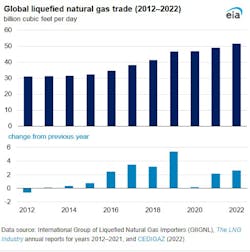In 2022, global trade in LNG increased by 2.6 bcfd (19 million tonnes/year (tpy)), or 5% compared with 2021, to average 51.7 bcfd, according to data from CEDIGAZ as published by the US Energy Information Agency (EIA). Growth in global LNG trade was supported by liquefaction capacity additions, primarily in the US, and increased demand in Europe as LNG continued to displace pipeline natural gas imports from Russia in the wake of its invasion of Ukraine.
LNG exports in 2022 increased the most from the US, growing by 1.4 bcfd (16%) compared with 2021. In first-half 2022, the US became the world’s largest LNG exporter for the first time, after Venture Global LNG Inc.’s 10-million tpy Calcasieu Pass plant was commissioned in Cameron Parish, La.. However, the shutdown of Freeport LNG Development LP’s 15-million tpy plant on Quintana Island, Tex., caused US LNG exports to decline in the second half of the year. Qatar and Australia were the other top two global LNG exporters in 2022; Qatar’s exports averaged 10.5 bcfd, and Australia’s averaged 10.4 bcfd.
LNG exports also increased from Malaysia, Norway (after Equinor ASA’s 4.3-million tpy Hammerfest LNG plant returned to service), Trinidad and Tobago, Russia, Oman, and Equatorial Guinea by a combined 1.3 bcfd. In North Africa, LNG exports from Algeria and Nigeria decreased by a combined 500 MMcfd, as these countries continued to experience issues with domestic natural gas production, EIA said.
Among LNG-importing regions, Europe (including Türkiye) posted the largest increase in LNG imports globally, up 65% (6.5 bcfd) compared with 2021. LNG imports declined by 9% (3.2 bcfd) in Asia and by 34% (800 MMcfd) in Latin America compared with 2021. LNG imports into EU-27 countries and the UK increased substantially in 2022—by 73% (6.3 bcfd) compared with 2021—replacing imports by pipeline from Russia. Five countries—France, the UK, Spain, the Netherlands, and Belgium— increased LNG imports by a combined 5.4 bcfd, accounting for 85% of the total increase.
In 2022, Japan returned as the world’s largest LNG importer—the title it held for more than 50 years until 2021—retaking the top spot from China. Although LNG imports into Japan declined last year by 3% (300 MMcfd), averaging 9.5 bcfd, imports into China declined 20%, in part because of zero-COVID policies, increased imports by pipeline from Russia, and higher use of coal. Other Asian countries, particularly those more reliant on global LNG spot markets, reduced spot purchases because of record-high LNG prices last year, according to EIA. LNG imports into India, Pakistan, and Bangladesh declined by a combined 18% (900 MMcfd) in 2022 compared with 2021.
In Latin America, Brazil had the largest decrease in LNG imports—70% (600 MMcfd)—mainly because more electricity was generated by hydropower, reducing demand for natural gas-fired generation in 2022 compared with 2021.
